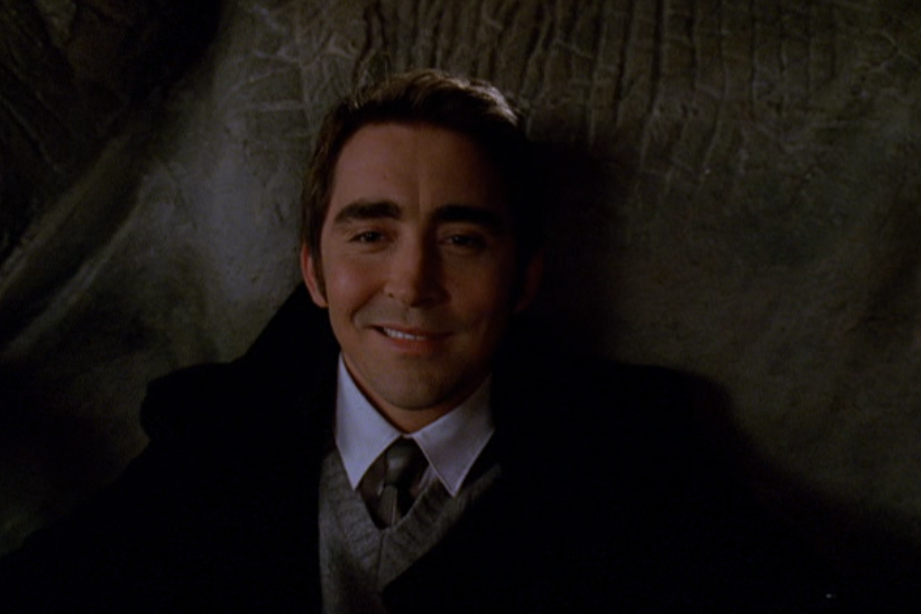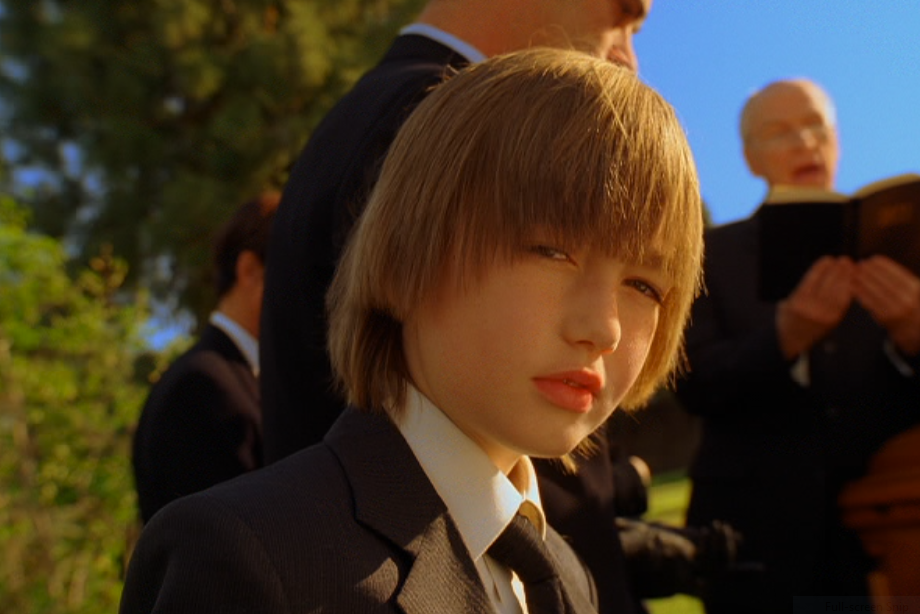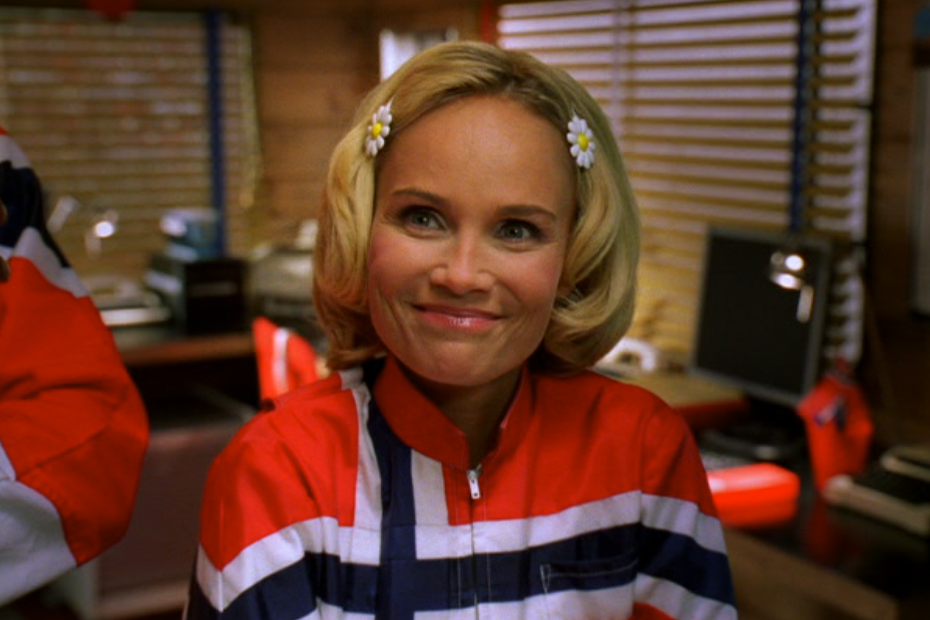Bye, Bye, Mr. American Pie
Costume Design on Pushing Daisies
I’ll admit, this edition’s punny title came before I wrote one word of the text, but in retrospect, it’s fitting. Yes, Pushing Daisies is a show about a pie maker, but it’s also, I would argue, a show about America—albeit a strange one, floating both in and out of time. When one character made an offhand reference to Reagan, I jump-scared—not just because, well, Reagan, but because I didn’t realize this was a universe in which he even existed. That’s how deep the show draws you into its “forensic fairy tale”: the set design intentionally excluding traces of modern technology, like cell phones and computers (Pushing Pixels); the costumes ranging in decade from the forties to the aughts (with the noted exception of the eighties—suck it, Reagan) (The New York Times). The colors are bright and warm, the prints playful and fun, and the stories not a little bit grim.
As the show’s narrator, Jim Dale, would say, the facts are these: When Ned was a boy, he discovered a gift—and, as in almost all fairy tales, a curse. He can wake the dead with the touch of his finger; with a second touch, they return to the afterlife. The time in between is just as consequential: if the person survives for more than a minute, another living thing in close proximity will die instead.
After unintentionally killing both his mother and the father of his childhood sweetheart, Ned learns to manage this power—and keep it to himself. Only two other people have seen him in action: The first is Emerson Cod, a PI who uses Ned’s gift to make quick work of murder investigations. The second is that aforementioned sweetheart, Charlotte “Chuck” Charles. Ned wakes her, intending to solve her recent murder, but can’t bring himself to give her up again. And so, she carries on her life as part of Ned’s: hanging out his pie shop; befriending his waitress, Olive Snook; solving crimes with Emerson; and avoiding her aunts Lily and Vivian, who still believe she is dead.
A dandelion-powered car model in 1.2
Sadly, Pushing Daisies survived only two seasons—cut short by both the Writers Guild strike and an untimely cancellation. What remains is plagued by dead and undead storylines and a whirlwind resolution in the last minute or so of the finale. And yet, the show is still mostly a delight to watch and rewatch—largely, I think, because of the balance it strikes: the sweetness of Chuck and Ned’s romance is cut by the saltiness of Emerson and Olive; the violence of the episodic murders is tempered the absurdity of their circumstances. (Hell, I know there’s been a lot of memes about wanting to live in Richard Scarry’s Busytown, but where is my Pushing Daisies universe? When am I getting my silly little Pushing Daisies job? Pop-up bookstore owner, retired windmill keeper, department-store window dresser—I’ll take them all!)
Buzz-worthy costumes in 2.1
Picking up some new habits in 2.1
Naturally, much credit for the show’s visual appeal is due to its costume designer, Robert Blackman. He won an Emmy for the season two premiere, “Bzzzzzzzzz!”—no wonder, as its bee-themed uniforms and Sound of Music–inspired habits are a kitschy delight. Indeed, as my ode to Pushing Daisies jobs suggests, this world is full of campy workwear, from the bold, candylike stripes of a candy store owner to the fluffy headpiece of a dandelion-powered car model (above). (I wasn’t surprised to find Blackman’s previous jobs were largely in the Star Trek universe—uniforms abound!)
In a way, each of its characters has their own uniform, too: a set color palette, decade, and mood to their wardrobe. . . .
Ned
Let’s start with Ned, and a moment to appreciate Lee Pace’s glorious eyebrows.
Ned in 2.11
Ah, that’s nice.
Ned in 1.1
Throughout the series, Ned sticks to simple, nondescript pieces—button-downs, henleys, slacks—in “solid blacks, grays, and whites” (The New York Times). Even his underwear (looking respectfully!) is black and gray.
Ned in 1.6
According to the Times, Blackman didn’t want the viewer to “lose sight” of their central character among the rest of the cast’s rainbow. (In fact, the only color you almost never see on Pushing Daisies is blue, thanks to a producer’s Nora Ephron–like disdain for it.)
Ned in 1.5
Ned’s absence of color also gives him a moodiness that matches his generally anxious and pessimistic personality. He is the show’s undertaker, its Grim Reaper, its gentleman of perpetual mourning, and his dark clothes—most especially his sweeping black trench—befit that role.
Note, too, how the red ties him to Chuck and the strawberries she’s cutting (1.8)
Now, he does let in an occasional blip of color—usually in an emotional moment or for the sake of an investigation. The above red necktie he wears when he and Chuck define their relationship; his bee-striped necktie, shown earlier, is worn to pose as a receptionist.
Ned in 2.5
Print, too, is rarely found in Ned’s wardrobe—only the occasional pinstripe. The pattern ties him to both Olive and Emerson, who wear it frequently as waitress and PI, respectively; by wearing pinstripes, too, Ned shows his connection to both of their work.
Young Ned fits perfectly into his childhood home’s green kitchen—funnily enough, the same color he’ll later use in the Pie Hole (1.1).
These stripes also subtly evoke childhood Ned. In flashback, prior to his mother’s death, he’s shown wearing bright striped polo shirts. His shift from color to neutral, from pattern to solid, reflects the seismic loss he’s experienced. (After all, the other characters, when shown as children, are almost always dressed as they are as adults.)
Young Ned in 1.1
The next time we see young Ned, he’s wearing a black suit and necktie for a funeral—essentially a mini version of the outfit an adult Ned will wear for Chuck’s own funeral.
Chuck
Chuck in 1.3
Chuck is the sunshine to Ned’s rain cloud, the sweet to his bitter: When she joins Ned and Emerson in waking the dead, she wants to know the deceased’s final wish—not just who killed them. After a reclusive existence with her agoraphobic aunts and a brush with death, Chuck is ready to live.
Chuck in 2.1
Note the daisy-like barrette made of ribbon (2.2)
Her wardrobe is equally vivacious, often rendered in warm, bright colors like yellow, orange, and red. Flowers are a favorite pattern and hair accessory—after all, they’re a symbol of life, a food source for the bees Chuck keeps, and a nod to the show’s title. And of course, her silhouettes are classic fifties and early sixties: full skirts, pedal-pusher pants, collared blouses. I can only assume Chuck was placing a lot of orders with Modcloth, as the show was airing just as that vintage-inspired retailer was taking off—and as we all were becoming equally obsessed with fellow twee icon Zooey Deschanel.
Chuck in 1.5
Chuck in 1.8
When Chuck ventures into the world outside The Pie Hole, she adds obscuring accessories—usually some combination of a head scarf, a hat, and giant sunglasses. These items are meant to protect Chuck from any unwanted attention, but they also give her an opportunity to play into the theme of the week’s murder. Note, for example, the jockey cap she wears when investigating the murder of a jockey or the yellows she chooses when solving the murder of a beekeeper.
The Aunts
Aunt Lily (left) and Aunt Vivian (right) in 1.1
Though her aunts believe her to be dead, Chuck stays connected to them through the pie maker and friends. Aunts Lily and Vivian were once renowned synchronized swimmers—the Darling Mermaid Darlings—but they’ve since become reclusive, rarely leaving their Victorian mansion. Indeed, their house and wardrobe have become a scrapbook of their travels, the outside world brought inward. Though each sister has a favored silhouette—Lil prefers pants to Viv’s dresses—their outfits share the same motifs:
The aunts in 2.7
First, animal skins and prints—zebras, tigers, leopards, and the like. Their furry fashions are both a callback to the aunts’ world travels and a reflection of their current, caged state (heck, there are multiple birdcages and taxidermized animals in their living room alone).
The aunts in 1.3
Second, loungewear: Both Lil and Viv love a slip or robe around the house, sometimes mixed with their more public-facing pieces. Their luxurious fabrics and fancy trims almost pass them as daywear.
Jeebus (2.13)
The aunts in 1.4
Last, and most unpleasantly, chinoiserie: a fetishization that spans the Pushing Daisies universe. (I mean, just look at the season two episode in which Chuck and Olive dress as dim sum waitresses.) The most obvious example is the aunts’ warm-up costumes—like really, what the hell are those?—but their civilian clothes are equally suspect: Viv, in particular, frequently wears cheongsams. The intention, I’m sure, was to hint at the aunts’ past travels, but the effect is appropriative.
Emerson
Emerson in 1.1
Unsurprisingly, Pushing Daisies is not exactly a model for racial representation, Emerson being show’s only lead of color. In early episodes, his wardrobe sometimes skirts into trope, and his role into sassy sidekick. (A black leather blazer? What is he, Shaft?) But as the show unfurls, so do his storylines. We learn that he’s seeking his long-lost daughter, through the form of—what else—a children’s pop-up book.
Emerson in 2.2
Emerson in 2.7
In style, Emerson becomes the show’s “noir dandy”: his blazers plaid and pinstripe, his pocket squares silk, his wingtips “custom cobbled.” The browns and grays of his suits pick up the dark palette of his detective office, while his printed shirts add a pop of color. No outfit is complete without a snappy fedora.
Emerson in 2.1
Emerson’s wardrobe also often incorporates his love of knitting, through a rotation of colorful sweater vests: a soft layer for his secretly soft heart.
Olive
Olive in 1.2
Last, but not least, is Olive. Like the other characters, she has her own uniform, though hers is quite literal: a zip-up sleeveless dress, either in green or orange pinstripe. Like her off-duty clothes, Olive’s waitress uniform shows her penchant for a little decolletage and leg—and mid- to late sixties fashions.
The fur coat, of course, is the aunts’ (2.13).
Olive in 1.5
While Chuck’s clothes lean toward the earlier half of the decade, Olive loves a mod silhouette and a groovy, Pucci-like print. Sometimes, she goes as far as a seventies-style wrap dress or even an aughts-era halter dress. Her style speaks to her pluck, her independence—she may be hopelessly in love with Ned, but damn it, she’s her own woman, too!
Olive in 1.1
Olive in 2.10
In fact, she rarely wears floral, the print most associated with Chuck. The only time she seems to allow herself it is in her own apartment: in her pajamas, her wallpaper, her couch. It’s her interior life, perhaps, the place (outside of song) where she most allows herself to be soft and romantic. In a season two episode, when she becomes a double agent with another detective firm, her barrettes hint at her true allegiance: pushing daisies, always.
Now, a note: After a lot of thought, I’ve decided to do away with my monthly newsletter schedule. While I love researching and writing my monthly posts, they still require a sizable chunk of time to make them into something I hope will be worth reading. (And, quite frankly, it’s frustrating to put that amount of effort into a newsletter only to have Gmail arbitrarily send it to spam.) This doesn’t mean I’m stepping back from the newsletter altogether—I still have plenty of ideas! But you will see posts on a less frequent and predictable schedule, as I have the time and excitement for them. I hope this will make Suds more sustainable and enjoyable for me (and you) in the long-term.
As always, I am so grateful for your readership over (almost four!) years. xoxo Chrisinda





























